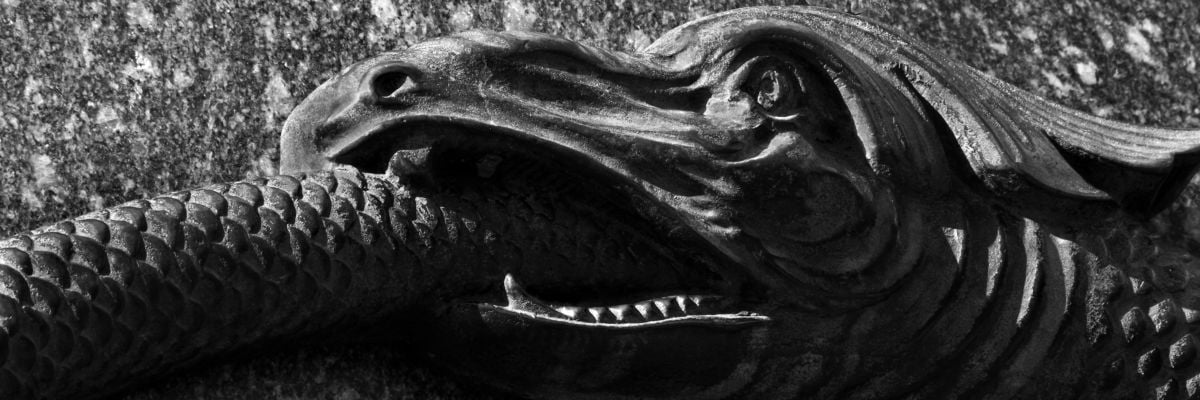
The so-called “wisdom” of the world is rife with incoherencies. One of the more trendy and pernicious examples of our time is transgenderism. Like relativism, transgender philosophy looks compelling, maybe even commonsense, on the surface. But when you examine it closely, you discover that it devours itself, like the Ouroboros, the creepy ancient symbol of a snake devouring its own tail.
Consider that transgenderism, or at least one form of it, claims that an individual’s identity as male or female—that is, his understanding of himself—can be in conflict with the biological sex that he was conceived with. A biological male, so it’s argued, can have a female gender identity, and vice versa.
Here is where the snake begins to devour its tail. Consider a male who thinks his gender identity is female. He identifies with the female form because he thinks his gender identity is female. He may even seek to assimilate such a form via surgery and doctor-prescribed hormones.
But already we’re running into problems. Our gent denies the connection between biological sexual forms and gender identity. That is to say, he thinks his biological maleness doesn’t indicate his gender identity. But at the same time, he’s seeking a connection between gender identity and biological sexual forms insofar as he identifies with and seeks to take on the female form to match his female gender identity.
What does this amount to? A contradiction: there’s no connection between biological sex and gender identity, and yet there is a connection, at the same time and in the same respect.
Now, an advocate of transgenderism might counter, “Well, for some, it’s not the biological female form that the man might identify with, but rather the female form that’s socially constructed: the wearing of high heels, makeup, long hair, and a curvy figure.”
But the same logical problem arises. If the socially constructed male form (the wearing of flat shoes, short hair, robust figure, etc.) is not indicative of one’s gender identity, then the socially constructed female form would not be indicative of one’s gender identity, either. And if that’s the case, then in principle, there is no way for the man to identify with the socially constructed female form because such a form isn’t connected to a female gender identity. So, in this scenario, like the above, we would have to deny the connection between gender identity and socially constructed maleness or femaleness and affirm that same connection at the same time and in the same respect. That’s a contradiction, which we can’t accept.
There’s another way in which the transgender philosophy is logically incoherent: it ends up defining woman in terms of what it means to be a woman. To the question, “What is a woman?”, a transgenderist only can give one answer: “a person whose gender identity is female.” The answer can’t be a biological female because transgender philosophy separates gender identity from biological sex. Nor can the answer be female social stereotypes since gender identity is supposedly innate, and thus, it’s supposed to precede such stereotypes. Therefore, female gender identity is the only game in town when it comes to defining what a woman is.
Can you see the problem here? Let me help you out: it’s a vicious circle! This view of woman defines the word in terms of woman, inserting what we’re trying to define into the definition. It’s a recursive nightmare, again like our friend the Ouroboros.
Another problem emerges: to what does female gender identity refer? If it refers not to biological sex, or to societally enforced norms, or to the inner sense of self (lest we end in a vicious circle), then female gender identity seems to refer to nothing. As philosopher Robert P. George puts it, “there seems to be no ‘something’ for [the inner sense of gender identity] to be the sense of.” If female gender identity refers to nothing, then it’s unintelligible.
The only way out here is to say there’s no difference whatsoever between a male and female gender identity. But that would exclude many people who are accepted as members of the “trans” community, like our gent above. So maybe the transgender philosophy is not so inclusive after all.
It’s important to emphasize that the above critiques are aimed at the ideas or the ways of thinking that transgender philosophy embodies. They are not aimed at the individuals who may have legitimate confusion regarding their sexual identity. Our hearts go out to these people, and we love them. And it’s precisely because of our love for them that we expose the logical incoherencies of the transgender philosophy. We are made for truth. And that’s the only thing that will make us truly happy!



